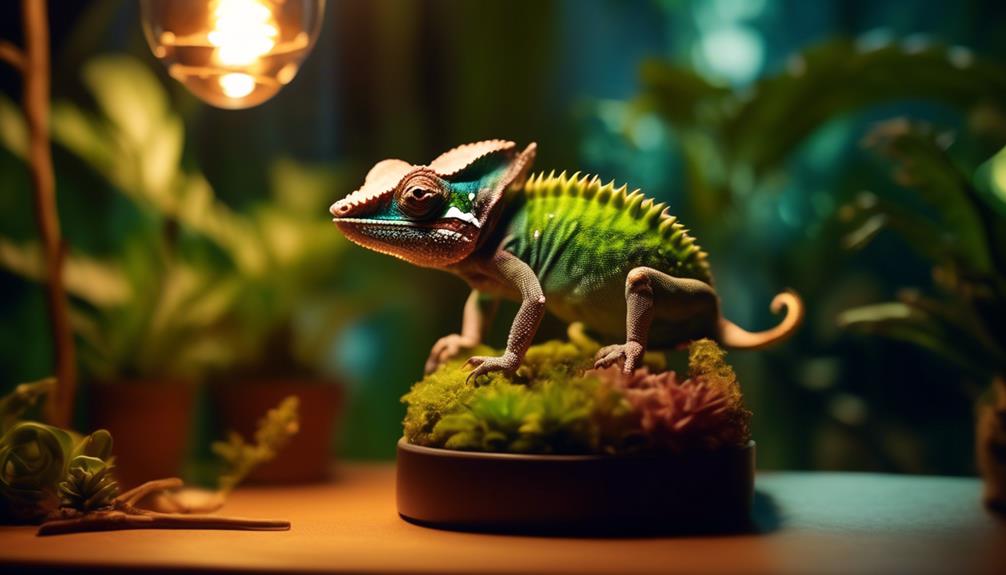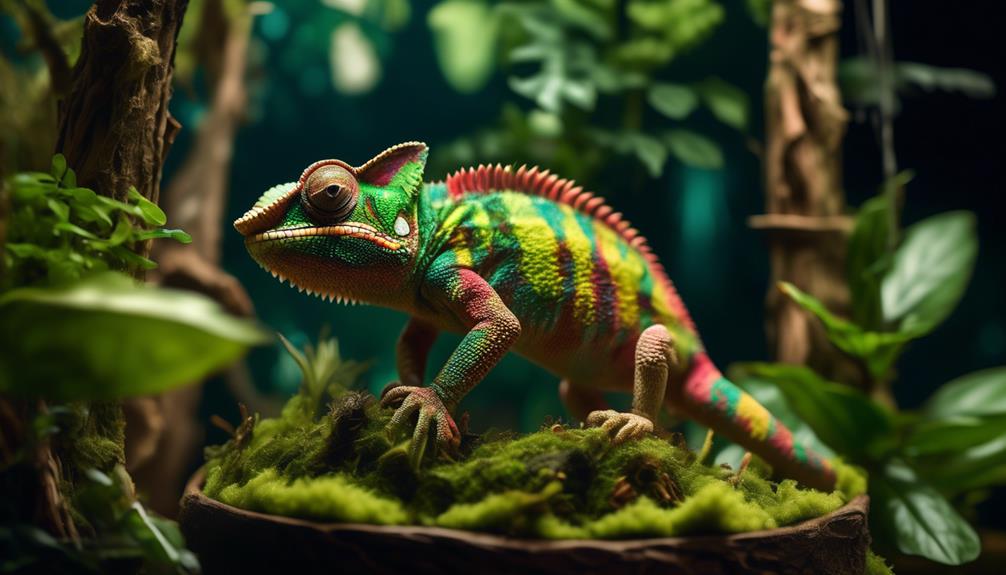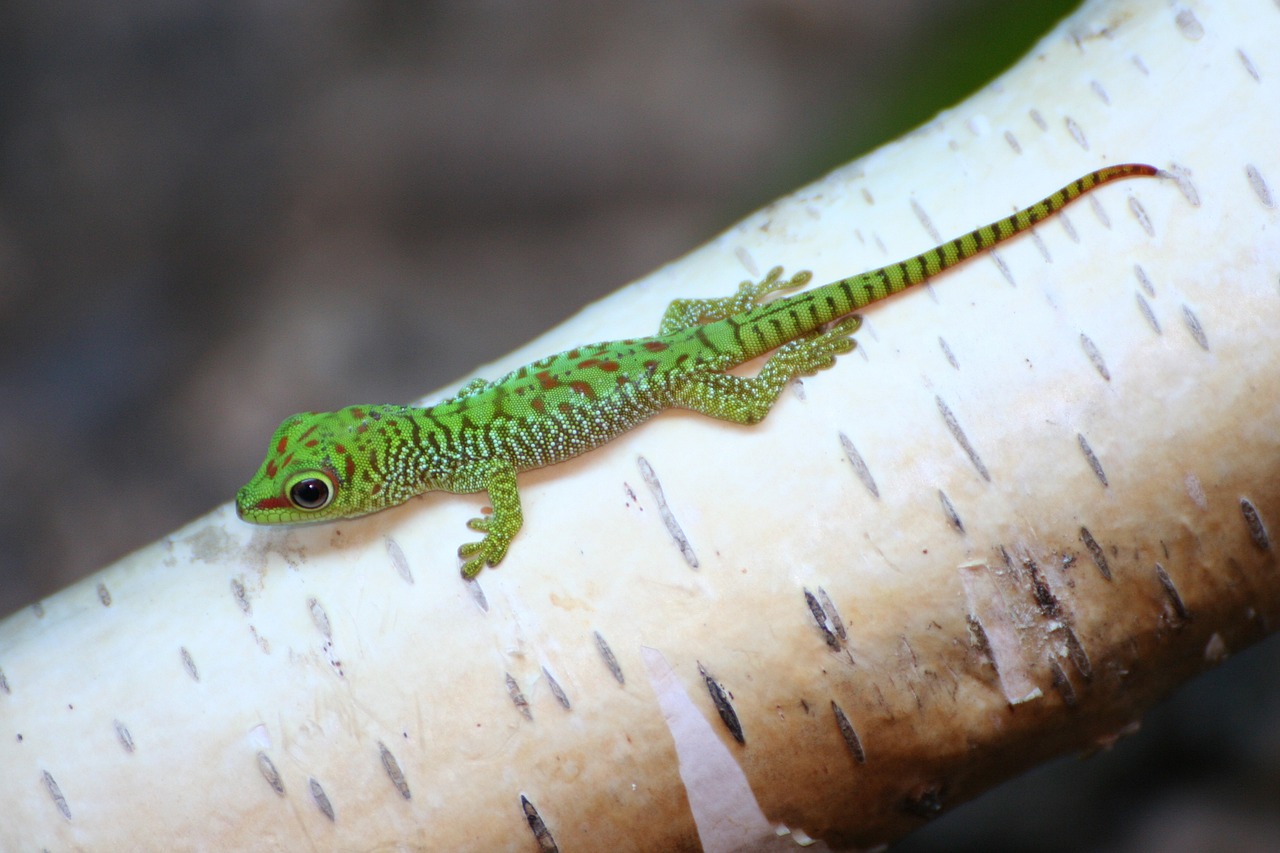They say, 'Home is where the heart is.' And what better way to show our love for our Cuban False Chameleons than by creating the perfect habitat for them?
In this guide, we will take you on a journey, uncovering the secrets to designing a space that caters to their unique needs. From housing requirements to UVB lighting, basking temperatures to humidity levels, and substrate choices to decor options, we will leave no stone unturned.
So, join us as we embark on this quest to create a thriving sanctuary for our beloved reptilian companions.
Key Takeaways
- Cuban false chameleons require an 18 x 18 x 36 terrarium for effective thermoregulation and exercise.
- Cohabitation is not recommended as it may lead to fighting or breeding.
- Cuban false chameleons need exposure to UVB light for their survival, with recommended UVB bulbs for their terrarium.
- The basking temperature should be around 90°F, with a cooler temperature in the lower regions of the enclosure.
Housing Requirements

When it comes to housing requirements for Cuban False Chameleons, it's essential to provide them with an 18 x 18 x 36 terrarium that allows for effective thermoregulation and ample space for exercise. This terrarium size is suitable for a single chameleon and ensures they've enough room to move around comfortably.
Cohabitation, or housing multiple chameleons together, isn't recommended as it can lead to fighting and breeding, which may cause stress and harm to the chameleons. It's crucial to prioritize the well-being of these reptiles and avoid potential risks associated with cohabitation.
UVB Lighting
To ensure the survival and well-being of Cuban False Chameleons, providing them with proper UVB lighting is essential. Choosing the right UVB bulb is crucial for replicating their natural environment and enabling them to thrive.
For an 18 x 18 x 36 terrarium, recommended UVB bulbs include the Arcadia ShadeDweller Kit, Arcadia T5 HO 6%, and Zoo Med T5 HO 5.0. These bulbs emit the necessary UVB rays that the chameleons require for their overall health.
Proper placement of the UVB lighting is also important. The UVB bulb should be housed in a reflective fixture and positioned close to the heat lamp. This ensures that the chameleons receive the optimal amount of UVB exposure while basking.
Basking Temperatures

Properly maintaining basking temperatures is crucial for the health and well-being of Cuban false chameleons in their habitat. Here are four important considerations when it comes to basking temperatures for these reptiles:
- Basking spot: Provide a designated area in the enclosure where the chameleons can bask and absorb heat. This spot should be located near the heat source and should have a temperature of around 90°F.
- Heat source: Use a ~40w heat bulb as the primary heat source for the basking spot. Avoid using ceramic heat emitters, red bulbs, or blue bulbs, as they may not provide the appropriate heat levels needed by the chameleons.
- Temperature gradient: The lower regions of the enclosure should be cooler, ranging between 77-80°F. This temperature gradient allows the chameleons to regulate their body temperature effectively.
- Basking surface: Place a sturdy branch approximately 6-8 inches below the heat lamp to serve as the basking surface. This allows the chameleons to perch and absorb heat comfortably.
Humidity Levels
Maintaining appropriate humidity levels is essential for the health and well-being of Cuban false chameleons in their habitat. These reptiles require a moderately high humidity environment, with an average humidity of around 80%.
Throughout the day, the humidity can fluctuate between 40-60%, while at night it can reach up to 100%. To achieve and maintain optimal humidity levels, it's recommended to mist the enclosure with a sprayer in the morning and evening. This helps to simulate the natural moisture found in their native habitats.
In dry climates, additional humidity control may be necessary, such as using a fogger and humidistat to supplement humidity.
It's important to note that humidity also serves as a crucial source of drinking water for Cuban false chameleons, further highlighting the significance of maintaining the appropriate levels in their habitat.
Substrate and Decor

Our selection of substrate and decor plays a crucial role in creating a suitable and enriching habitat for Cuban false chameleons. When it comes to choosing the right substrate, we must consider the natural environment of these chameleons. Recommended substrates such as Zoo Med Eco Earth, Zoo Med ReptiSoil, Exo Terra Plantation Soil, and Zilla Jungle Mix resemble the tropical soil found in their native habitats. These substrates have small particles and good moisture retention, providing a comfortable and suitable surface for the chameleons to walk on.
In addition to the substrate, the importance of decor in chameleon habitats can't be overstated. Small branches and twigs should be provided for basking, mimicking their natural environment. Live or artificial foliage should also be added for hiding, creating a sense of security for the chameleons. Densely planted enclosures are appreciated by Cuban false chameleons and can further enhance their environment, making it more stimulating and visually appealing.
Frequently Asked Questions
What Are the Common Health Issues That Cuban False Chameleons May Face and How Can They Be Prevented?
To prevent common health issues in Cuban False Chameleons, it's important to recognize and alleviate stress. Provide a suitable habitat with proper temperature, humidity, UVB lighting, and a balanced diet. Regular veterinary check-ups are also crucial for their well-being.
Can Cuban False Chameleons Be Housed With Other Reptile Species, Such as Geckos or Anoles?
Cuban false chameleons should not be housed with other reptile species like geckos or anoles. It is best to follow best practices for housing multiple reptile species together to ensure the well-being and safety of all involved.
How Often Should I Clean the Terrarium and What Is the Best Way to Do It?
We clean the terrarium of our Cuban False Chameleons regularly to maintain a healthy environment. We recommend cleaning every 2-3 weeks using a reptile-safe disinfectant, removing any waste, and replacing substrate and decor as needed.
Are There Any Specific Dietary Requirements for Cuban False Chameleons?
Cuban false chameleons have specific dietary requirements and should be fed a variety of insects such as crickets, roaches, and mealworms. Feeding should occur daily, with dusted insects and occasional supplementation of calcium and vitamins.
What Are Some Signs of Stress or Discomfort in Cuban False Chameleons and How Can I Alleviate Them?
To understand signs of stress in Cuban false chameleons and alleviate them, observe for changes in behavior, appetite, and coloration. Provide proper environmental conditions, such as temperature, humidity, and hiding spots, and offer a balanced diet to prevent health issues.
Conclusion
In conclusion, crafting a captivating and cozy habitat for Cuban False Chameleons calls for careful consideration of housing, lighting, temperatures, humidity, substrate, and decor.
By adhering to the ideal terrarium size, implementing proper UVB lighting, maintaining optimal basking temperatures, and ensuring adequate humidity levels, you can create a haven for these remarkable reptiles.
With suitable substrate choices and thoughtfully selected decor, your Cuban False Chameleons will thrive in their new home.
So let your creativity soar and build a habitat that will truly impress!


